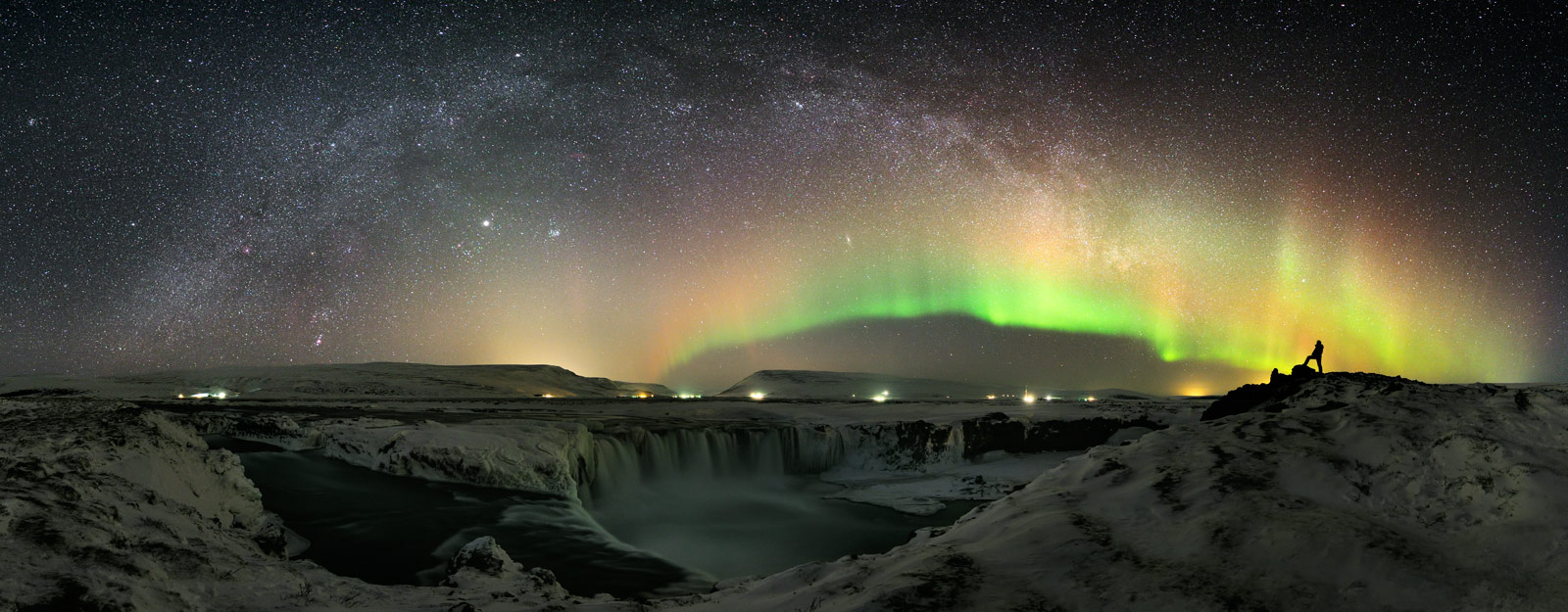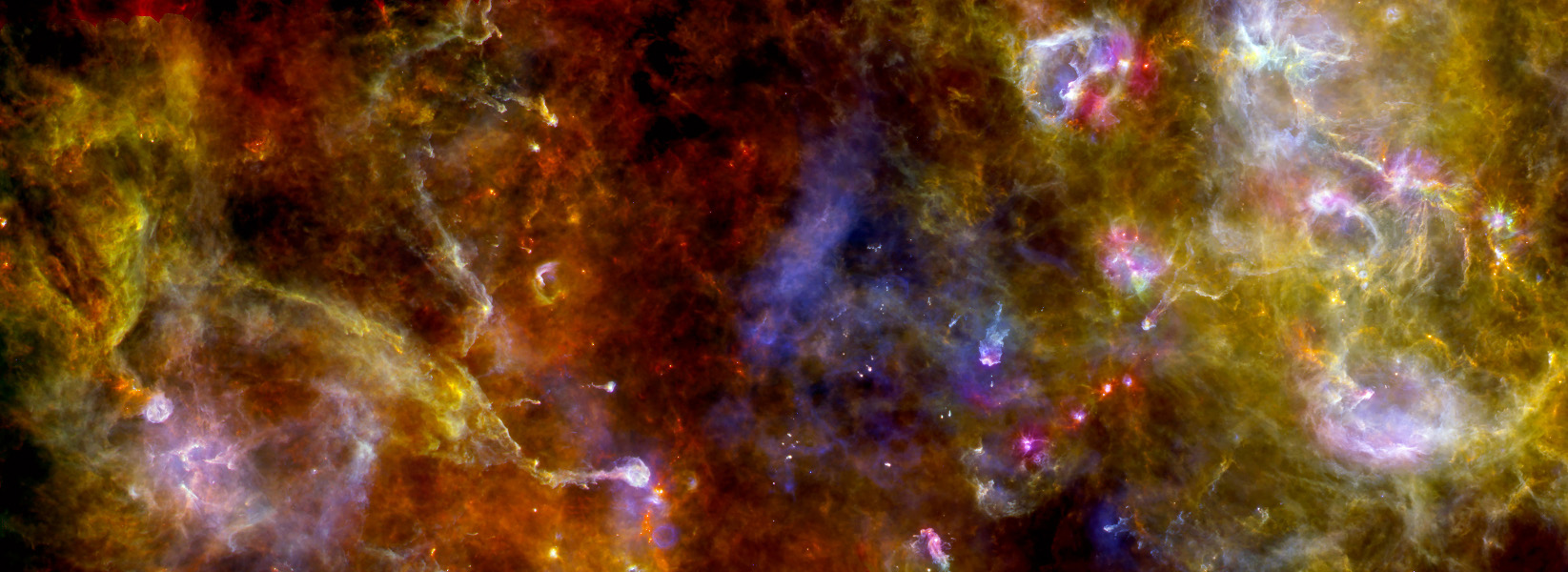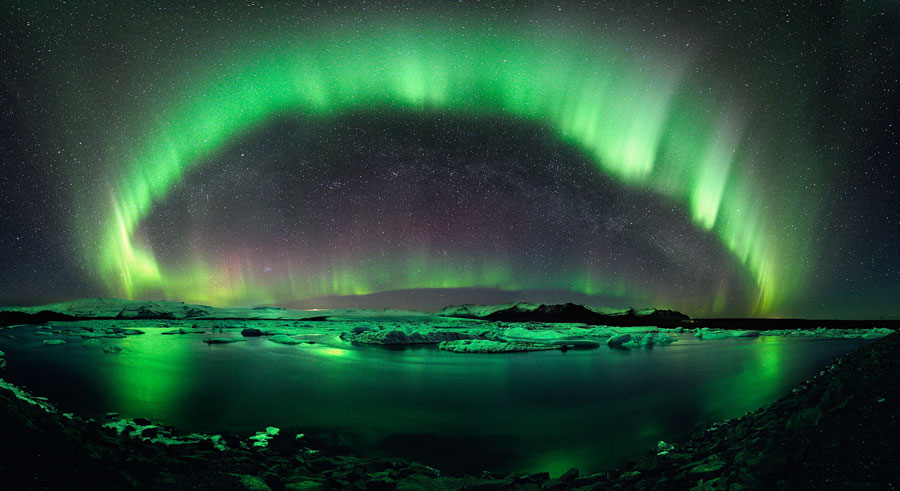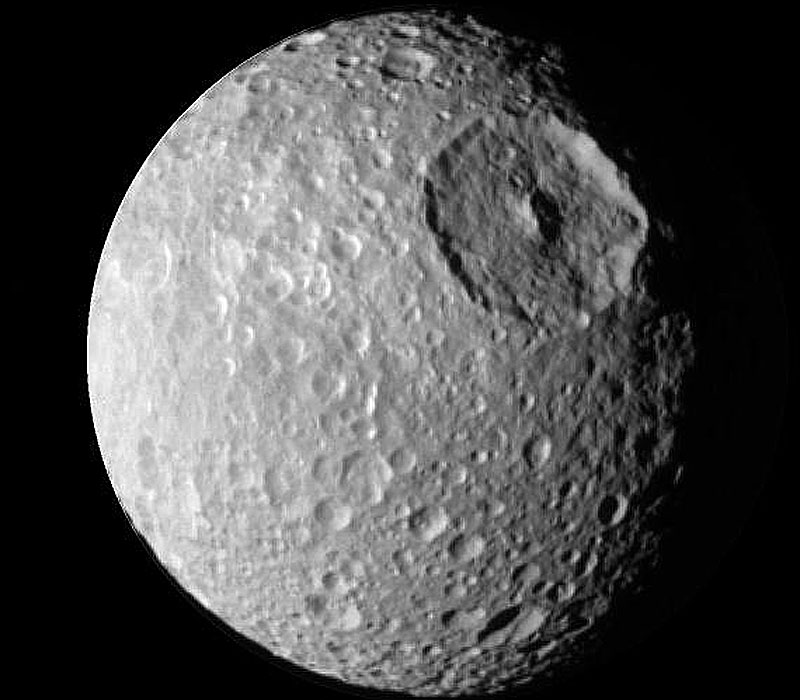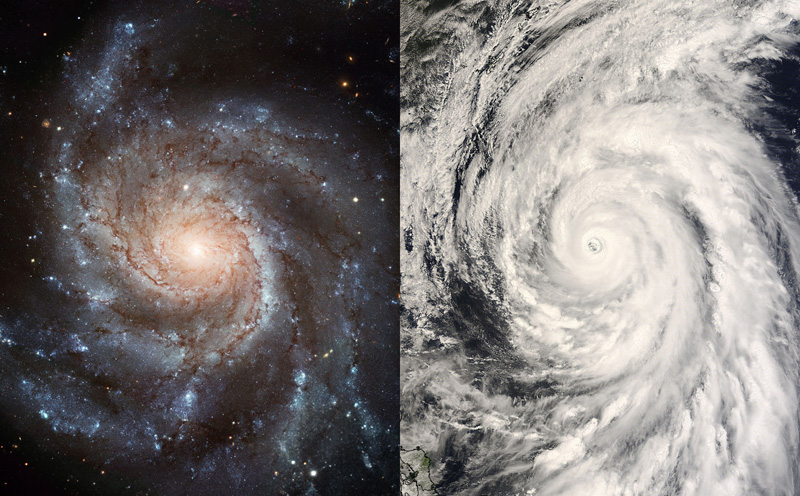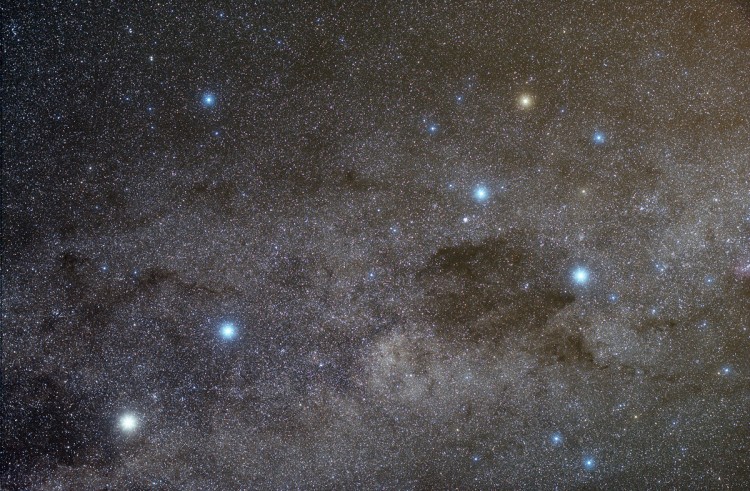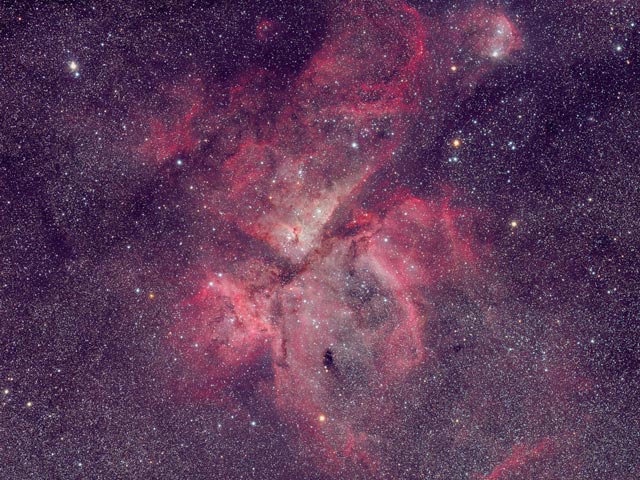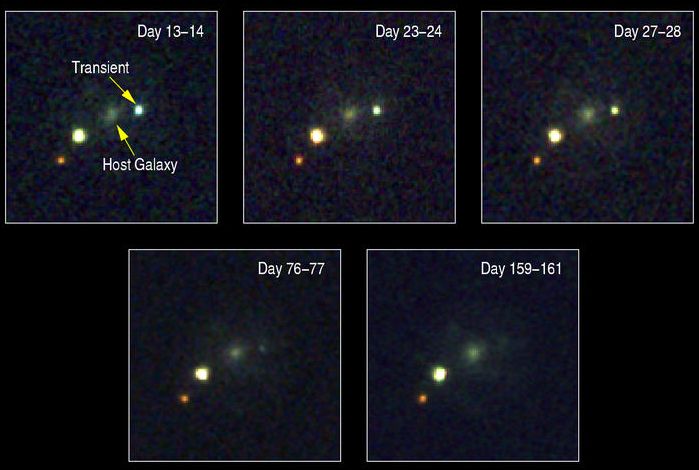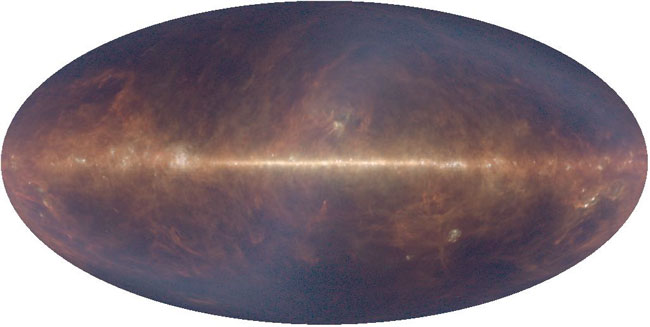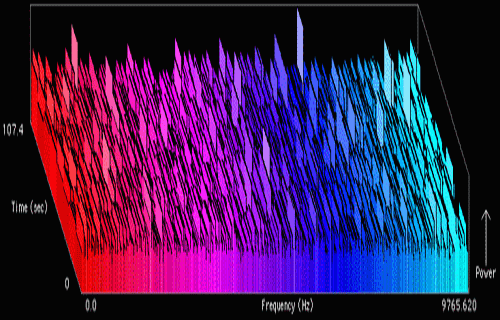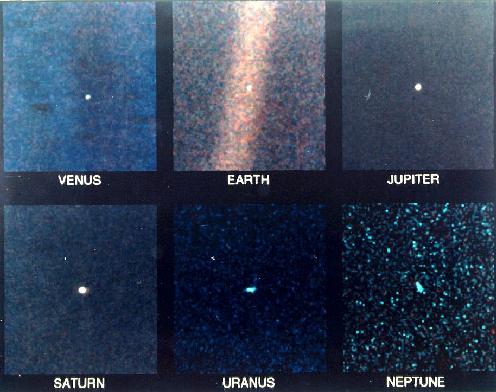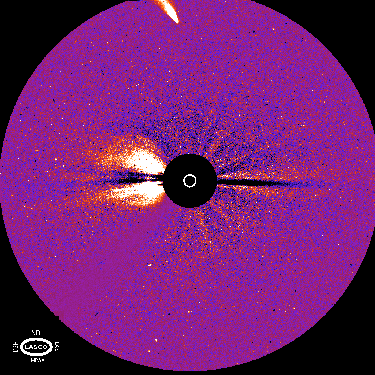| << Previous | Index | Next >> |
2015 Like a pearl, a white dwarf star shines best after being freed from its shell. In this analogy, however, the Sun would be a mollusk and its discarded hull would shine prettiest of all! In the above shell of gas and dust, the planetary nebula designated NGC 2440, contains one of the hottest white dwarf stars known. The glowing stellar pearl can be seen as the bright dot near the image center. The portion of NGC 2440 shown spans about one light year. The center of our Sun will eventually become a white dwarf, but not for another five billion years. The above false color image was captured by the Hubble Space Telescope in 1995. NGC 2440 lies about 4,000 light years distant toward the southern constellation Puppis.
2014 Gas giant Jupiter is the solar system's largest world with about 320 times the mass of planet Earth. It's also known for a giant swirling storm system, the Great Red Spot, featured in this sharp Hubble image from April 21. Nestled between Jupiter-girdling cloud bands, the Great Red Spot itself could still easily swallow Earth, but lately it has been shrinking. The most recent Hubble observations measure the spot to be about 10,250 miles (16,500 kilometers) across. That's the smallest ever measured by Hubble and particularly dramatic when compared to 14,500 miles measured by the Voyager 1 and 2 flybys in 1979, and historic telescopic observations from the 1800s indicating a width of about 25,500 miles on its long axis. Current indications are that the rate of shrinking is increasing for the long-lived Great Red Spot.
2013 Above this boreal landscape, the arc of the Milky Way and shimmering aurorae flow through the night. Like an echo, below them lies Iceland's spectacular Godafoss, the Waterfall of the Gods. Shining just below the Milky Way, bright Jupiter is included in the panoramic nightscape recorded on March 9. Faint and diffuse, the Andromeda Galaxy (M31) appears immersed in the auroral glow. The digital stitch of four frames is a first place winner in the 2013 International Earth and Sky Photo Contest on Dark Skies Importance organized by The World at Night. An evocative record of the beauty of planet Earth's night sky, all the contest's winning entries are featured in this video.
2012
2011 On some nights, the sky is the best show in town. On this night, the sky was not only the best show in town, but a composite image of the sky won an international competition for landscape astrophotography. The above winning image was taken two months ago over Jökulsárlón, the largest glacial lake in Iceland. The photographer combined six exposures to capture not only two green auroral rings, but their reflections off the serene lake. Visible in the distant background sky is the band of our Milky Way Galaxy, the Pleiades open clusters of stars, and the Andromeda galaxy. A powerful coronal mass ejection from the Sun caused auroras to be seen as far south as Wisconsin, USA. As the Sun progresses toward solar maximum in the next few years, many more spectacular images of aurora are expected.
2010 The see the full length of this blue whale, scroll right. NGC 4631 is a big beautiful spiral galaxy seen edge-on at only about 30 million light-years away. This galaxy's slightly distorted wedge shape led to its popular moniker of the Whale galaxy. The Whale's dark interstellar dust clouds and young bright blue star clusters highlight this panoramic color image. The band of NGC 4631 not only appears similar to band of our own Milky Way Galaxy, but its size is truly similar to our Milky Way as well. The galaxy is also known to have spouted a halo of hot gas glowing in x-rays. The Whale galaxy spans about 140,000 light years and can be seen with a small telescope toward the constellation of the Hunting Dogs (Canes Venatici).
2009 Whatever hit Mimas nearly destroyed it. What remains is one of the largest impact craters on one of Saturn's smallest moons. The crater, named Herschel after the 1789 discoverer of Mimas, Sir William Herschel, spans about 130 kilometers and is pictured above. Mimas' low mass produces a surface gravity just strong enough to create a spherical body but weak enough to allow such relatively large surface features. Mimas is made of mostly water ice with a smattering of rock - so it is accurately described as a big dirty snowball. The above image was taken during the 2005 August flyby of the robot spacecraft Cassini now in orbit around Saturn.
2008
2007 The glow of the southern Milky Way and the well-known Southern Cross are featured in this colorful skyscape recorded in April over La Frontera, Chile. The Southern Cross (Crux) itself is at the right of the 20 degree wide field of view, topped by bright, yellowish star Gamma Crucis. A line from Gamma Crucis through the blue star at the bottom of the cross, Alpha Crucis, points toward the south celestial pole. Against faint Milky Way starlight, the dark expanse of the Coal Sack Nebula lies just left of the cross, while farther left along the Milky Way are the bright stars Hadar and Rigil Kentaurus, also known as Beta and Alpha Centauri. Blazing in the lower left, Alpha Cen is the closest star to the Sun, a mere 4.3 light-years distant. In fact, yellowish Alpha Cen is actually a triple star system that includes a sun-like star. Seen from Alpha Cen, our own Sun would be a bright yellowish star in the otherwise recognizable constellation Cassiopeia.
2006 What causes the powerful explosions known as gamma-ray bursts? Astrophysicists still aren't sure, but the longest duration gamma-ray bursts (GRBs) seem to involve very massive stars. A new clue indicating this was uncovered recently by a series of images taken by the orbiting Hubble Space Telescope. These images, shown above, indicate that long duration GRBs typically appear to come from galaxies and regions of galaxies with bright regions rich with star formation and bright, massive stars. Long GRBs are therefore different than many types of supernovas, which occur more uniformly distributed in their host galaxies. Since such active star forming regions are relatively rare in our Milky Way Galaxy, the chances of a nearby GRB affecting life on Earth are relatively slight.
2005 Scroll right to see a breathtaking panorama of Mars from Larry's Lookout. The lookout occurs near the peak of Husband Hill in the Columbia Hills. The summit of Husband Hill is visible 200 meters in the distance toward the center of the 360-degree near-true-color picture. The robot rover Spirit took images that compose the above mosaic over four Martian days. After taking the image sequence, Spirit carefully picked its way to toward Husband Hill's summit. On the far right, near distant rover tracks, is a recently investigated area dubbed Paso Robles that was found to contain high amounts of sulfur.
2004 In one of the brightest parts of the Milky Way lies a nebula where some of the oddest things occur. NGC 3372, known as the Great Nebula in Carina, is home to massive stars and changing nebula. Eta Carina, the most energetic star in the nebula was one of the brightest stars in the sky in the 1830s, but then faded dramatically. The Keyhole Nebula, visible near the center, houses several of the most massive stars known and has also changed its appearance. The Carina Nebula spans over 300 light years and lies about 7000 light-years away in the constellation of Carina. The above image was taken from La Frontera in Alcohuaz, Chile. Eta Carina might explode in a dramatic supernova within the next thousand years, and has even flared in brightness over just the past decade.
2003 In low Earth orbit there is not enough atmosphere to diffuse and scatter sunlight, so shadows are black and the sky is dark - even when the Sun shines. The harsh lighting produced this dramatic effect as mission specialist Gregory Harbaugh photographed colleague Joseph Tanner during their second spacewalk to service the Hubble Space Telescope in February 1997. The aft section of the Space Shuttle Discovery is visible in the background with the Sun hanging over a delicate crescent of the Earth's limb. A checklist is attached to Tanner's left arm, and Harbaugh's reflection is just visible in Tanner's visor.
2002 On the 21st of November 2001, satellites detected yet another burst of gamma-rays from the cosmos. While this flash of high-energy photons lasted for less than a minute, eager astronomers have been following the fading optical light from the location of the burst source ever since. Seen above in a series of Hubble Space Telescope images recorded from December 4, 2001 to May 5, 2002 (13 through 161 days after the burst), the fading transient lies to the right of a fuzzy, distant galaxy, likely home to the gamma-ray burster. Two constant point-like objects to the left of the galaxy are foreground stars within our own Milky Way. The transient did not not simply fade away, though. Observations from the Hubble, OGLE, and the large Magellan telescope in Chile indicate that it bumped up or brightened again days after the burst in a convincing display characteristic of a supernova - the death explosion of a massive star. These results add to the mounting evidence that at least some of the mysterious cosmic gamma-ray bursts are produced in the violent event which ends the lives of massive stars.
2001 Neutrinos are subatomic particles generated by the nuclear reactions which power stars like our Sun. Flying outward from the Sun's core, they easily pass through the Sun (and almost anything else!) unimpeded and should be detectable by earth-based neutrino "telescopes". Still, to the long-standing consternation of astrophysicists, the observed flux of solar neutrinos is less than expected. In a new twist to this solar neutrino saga, an analysis of data from the GALLEX / GNO neutrino detector finds a solar neutrino flux that varies over about 27 days ... approximately matching the Sun's rotation period. In fact, since different parts of the Sun rotate at different rates, the neutrino flux variations match most exactly the rotation rates of the areas shown in red on this colorful cross-sectional map of the solar interior rotation. So how could solar rotation affect the neutrino flux? Some theoretical models say that neutrinos can change quantum properties when they interact with tangled solar magnetic fields and become particles that the neutrino experiments were not designed to detect. Then, as the Sun rotates, the neutrinos sometimes come to us unaffected and sometimes come through magnetic fields, diminishing the flux that can be measured.
2000 Three major sources contribute to the far-infrared sky: our Solar System, our Galaxy, and our Universe. The above recently released image, in representative colors, is the highest resolution projection yet created of the entire far-infrared sky (60 - 240 microns) created from years of observations by the now-defunct robot spacecraft COBE. Our Solar System is evidenced most prominently by the S-shaped blue sash called zodiacal light, created by small pieces of rock and dust orbiting between the Sun and Jupiter. The disk of our Galaxy is evidenced most prominently by the thin band of light-emitting dust that crosses the middle of the image. Clouds and filaments of dust in our Milky Way also make intricate patterns pervading most of the sky. Close inspection of similar images reveal that the background is not completely dark, indicating that our Universe itself provides a diffuse glow, created by dust left over from the star formation throughout the Universe.
1999 "Mom, can I use our computer to search for aliens?" Last week, the SETI@home project released free software that enables many home computers to search for signals from intelligent extra-terrestrials. These signals may have already been detected by the huge Arecibo radio telescope, but gone unnoticed due to the large amount of data that has been accumulating. SETI enthusiasts David Gedye and Craig Kasnoff realized that the enormous amount of computing power in people's homes might help. The resulting software can work as a screensaver and so after downloading a chunk of data, will only search for alien signals when the computer is otherwise idle. When running, the software will generate images like that shown above: a changing Fast Fourier Transform plot highlighting strong periodic signals. Although more likely to find false-alarms like known Earth-orbiting satellites, if your computer finds a true ET signal, SETI@home promises that you will be given due credit.
1998 After taking spectacular pictures of our Solar System's outer planets, Voyager 1 looked back at six planets to take our Solar System's first family portrait. Here Venus, Earth, Jupiter, Saturn, Uranus, and Neptune, were all visible across the sky. Each, however, was now just a small speck of light, dimmer than many of the stars in the sky. Voyager 1 is only one of four human-made objects to leave our Solar System, the other three being Voyager 2, and Pioneer 10 and Pioneer 11.
1997 This panorama view of the sky is really a drawing. It was made in the 1940s under the supervision of astronomer Knut Lundmark at the Lund Observatory in Sweden. To create the picture, draftsmen used a mathematical distortion to map the entire sky onto an oval shaped image with the plane of our Milky Way Galaxy along the center and the north galactic pole at the top. 7,000 individual stars are shown as white dots, size indicating brightness. The "Milky Way" clouds, actually the combined light of dim, unresolved stars in the densely populated galactic plane, are accurately painted on, interrupted by dramatic dark dust lanes. The overall effect is photographic in quality and represents the visible sky. Can you identify any familiar landmarks or constellations? For starters, Orion is at the right edge of the picture, just below the galactic plane and the Large and Small Magellanic Clouds are visible as fuzzy patches in the lower right quadrant.
1996 A rare coincidence was recently captured by the orbiting SOHO spacecraft. During the closest approach to the Sun of Comet Hyakutake on May 1, SOHO photographed the comet. By accident -- during the time this photograph was being taken -- a solar flare was being ejected from the Sun. Therefore, at the top of this false-color picture, Comet Hyakutake is visible, while emission to the left of the Sun is a solar flare. The Sun, at the center of the picture, was blocked by an artificial occulter in the LASCO telescope, allowing objects much dimmer than the Sun to be observed. SOHO was launched in December of 1995 and contains many instruments which study the Sun.
| << Previous | Index | Next >> |


